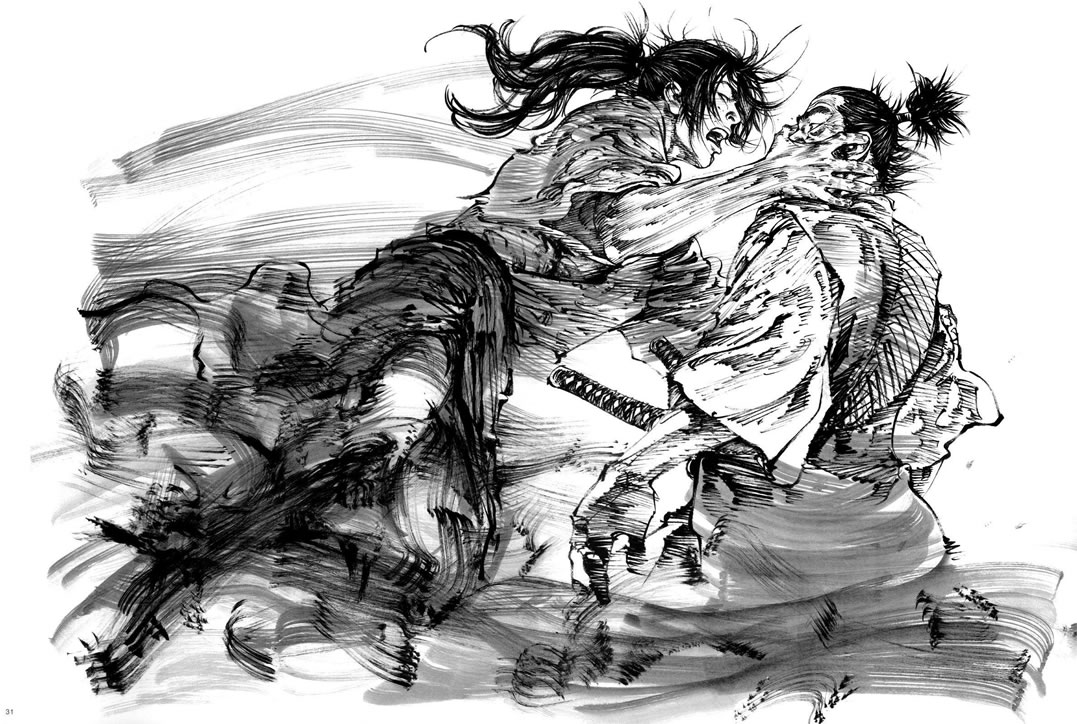Introduction TO vagabond manga
vagabond manga manga series created by Takehiko Inoue, has carved a significant niche in the realm of graphic storytelling since its debut in the late 1990s. Based on Eiji Yoshikawa’s historical novel Musashi, Vagabond reinterprets the life of the legendary swordsman Miyamoto Musashi, blending historical fiction with profound philosophical insights. Inoue’s unique artistic style and gripping narrative have not only captivated readers in Japan but have also garnered a global fanbase, solidifying Vagabond as a masterpiece in the manga genre.
This manga transcends typical action narratives, delving deep into themes of self-discovery, morality, and the essence of what it means to be a warrior. As we journey through the pages of Vagabond, we encounter a world where every duel carries weight beyond mere physical confrontation, revealing the characters’ internal struggles and aspirations. This article explores the storyline, artistic excellence, philosophical themes, and the lasting legacy of Vagabond, offering insights into why it remains a cornerstone of contemporary manga.
The Storyline
Synopsis of Vagabond
At the heart of Vagabond lies the story of Miyamoto Musashi, a historical figure whose exploits have become the stuff of legends. The narrative unfolds during Japan’s Edo period, where Musashi embarks on a quest not only to master the sword but also to discover his true self. The manga chronicles Musashi’s journey through various battles and encounters, each of which serves as a catalyst for personal growth and philosophical introspection.
Inoue’s storytelling is masterful; he intricately weaves together action, emotion, and character development. Musashi is portrayed as a complex character who grapples with his motivations, questioning the meaning of strength and victory. Alongside him is Sasaki Kojiro, his rival, whose path intertwines with Musashi’s in a series of epic confrontations. These battles are not merely physical; they embody the philosophical debates between the two warriors, exploring contrasting ideologies and life choices.
Historical Context
Understanding Vagabond’s narrative requires a glimpse into the historical backdrop of the Edo period. This era, marked by relative peace and stability, allowed for the flourishing of culture, arts, and philosophy. It was also a time when the samurai class held significant influence, and their codes of honor and conduct shaped societal values. Inoue’s portrayal of Musashi reflects the struggles of a warrior navigating this complex societal landscape, where honor, pride, and the relentless pursuit of mastery collide.
The manga draws inspiration from real events and historical texts, grounding its narrative in a rich tapestry of Japanese history. Musashi’s life, as depicted in Vagabond, captures the essence of a wandering samurai who seeks not just to conquer others but to conquer himself. Through Inoue’s lens, readers gain a deeper appreciation for the cultural significance of the samurai and the philosophical inquiries that define their existence.
Artistic Excellence
Illustrative Style
One of the most striking features of Vagabond is Takehiko Inoue’s illustrative style. His art transcends conventional manga aesthetics, utilizing intricate line work, dynamic compositions, and a keen eye for detail. Inoue employs a blend of realism and stylization, breathing life into the characters and settings. The expressive faces of Musashi and his companions convey a spectrum of emotions, from rage to introspection, allowing readers to connect deeply with their journeys.
The use of ink and brush techniques adds a layer of authenticity to the artwork, reminiscent of traditional Japanese painting. Inoue’s meticulous attention to backgrounds enriches the storytelling; the serene landscapes juxtaposed with intense battle scenes create a vivid contrast that enhances the narrative’s emotional impact. Each page of Vagabond is a testament to Inoue’s artistic mastery, showcasing not just skill but a profound understanding of visual storytelling.
Visual Storytelling
In Vagabond, illustrations do more than complement the text; they are integral to the storytelling itself. Key scenes are meticulously crafted, drawing readers into the heart of the action and the characters’ emotional landscapes. For instance, the climactic duels are depicted with a fluidity that captures the rhythm of combat, making readers feel the tension and urgency of each encounter.
Moreover, Inoue’s ability to convey subtle emotions through visual cues adds depth to the characters. Moments of silence, contemplation, and fleeting expressions tell stories that words alone cannot convey. This mastery of visual storytelling is one of Vagabond’s hallmarks, elevating it beyond a mere action manga to a profound exploration of the human condition.
Comparison with Other Manga
When compared to other notable manga, Vagabond stands out for its artistic ambition and philosophical depth. While many manga series focus primarily on action and adventure, Vagabond integrates these elements with introspective storytelling and character development. It invites comparisons to works like Berserk and Blade of the Immortal, both of which explore similar themes of conflict and morality but often through darker lenses.
Inoue’s unique approach to the samurai genre has influenced many contemporary manga artists. His emphasis on character-driven narratives and philosophical themes has set a standard that resonates throughout the manga community. As Vagabond continues to inspire new generations of artists, its impact on the medium is undeniable.
Philosophical Themes
The Way of the Samurai
Vagabond delves deep into the ethos of bushido, the code of conduct followed by samurai. Through Musashi’s journey, readers encounter the core principles of honor, loyalty, and self-discipline that define the samurai way. Inoue skillfully explores how these ideals shape Musashi’s decisions and relationships, illuminating the moral complexities of a warrior’s life.
As Musashi faces various challenges, he grapples with the expectations placed upon him as a samurai. The manga poses critical questions about the nature of strength and the meaning of victory. Is it enough to triumph in battle, or does true victory lie in self-mastery and understanding one’s purpose? These philosophical inquiries elevate Vagabond, making it a profound meditation on what it means to be a warrior in both historical and modern contexts.
The Quest for Self-Identity
A central theme in Vagabond is the quest for self-identity. Musashi’s journey is not just about physical conquest; it’s an exploration of his inner self. Throughout the narrative, he encounters various characters who challenge his beliefs and force him to confront his motivations. Each duel and encounter becomes a metaphor for his internal struggles, pushing him closer to understanding who he truly is.
Inoue masterfully captures this existential journey, illustrating Musashi’s transformation from a brash, inexperienced fighter to a contemplative warrior seeking purpose. This evolution resonates with readers, who can relate to the universal quest for identity and meaning in their own lives. Vagabond becomes a mirror reflecting the complexities of self-discovery and the human experience.
The Nature of Conflict
Conflict is an omnipresent theme in Vagabond, manifesting in both physical and moral dimensions. The battles Musashi engages in are not just tests of skill but also serve as reflections of his inner turmoil. Each confrontation forces him to confront his values and beliefs, leading to moments of profound realization. Inoue explores the duality of conflict: the necessity of fighting for one’s beliefs while grappling with the moral implications of violence.
Through Musashi’s encounters, the narrative examines the consequences of conflict on personal relationships and societal structures. Characters are often faced with dilemmas that challenge their ethics, prompting readers to reflect on the nature of honor and duty. Vagabond transcends mere action; it invites contemplation on the complexities of human existence and the choices we make.
The Legacy of Vagabond
Critical Acclaim and Awards
Vagabond has received numerous accolades and critical acclaim, solidifying its status as a landmark in the manga world. It has won several prestigious awards, including the Kodansha Manga Award and the Eisner Award, recognizing its excellence in storytelling and artistry. Critics and fans alike have praised Inoue’s ability to blend action with philosophical depth, creating a work that resonates on multiple levels.
The series has also been included in various “best of” lists, often cited as one of the greatest manga of all time. Its enduring popularity speaks to its universal themes and the timeless nature of Musashi’s journey. Vagabond’s critical success has paved the way for discussions about the artistic merit of manga as a legitimate form of literature, elevating its status within the global literary canon.
Influence on Pop Culture
The influence of Vagabond extends beyond the pages of manga; it has left an indelible mark on pop culture. The story has inspired adaptations into other media, including anime and live-action films, allowing new audiences to engage with Musashi’s narrative. These adaptations, while varying in their fidelity to the source material, serve to introduce Vagabond’s themes to a broader audience.
Moreover, Vagabond’s impact can be seen in various cultural references, from video games to literature. The archetype of the wandering samurai, as embodied by Musashi, has become a recurring motif in modern storytelling. Inoue’s work has helped shape the portrayal of samurai in popular culture, influencing how these figures are depicted in various narratives across different media.
Fan Community and Continued Interest
The fan community surrounding Vagabond is vibrant and passionate, contributing to its ongoing legacy. Online forums, fan art, and social media discussions reflect the deep appreciation fans have for Inoue’s work. This active community helps sustain interest in Vagabond, even years after its initial publication.
Merchandising, including art books, figures, and collectibles, further supports the manga’s legacy, allowing fans to engage with the world of Vagabond in new ways. Conventions often feature discussions and panels dedicated to the series, highlighting its impact on the manga landscape. The continued enthusiasm for Vagabond underscores its status as a timeless classic, ensuring that it remains relevant in contemporary discussions about manga and storytelling.





